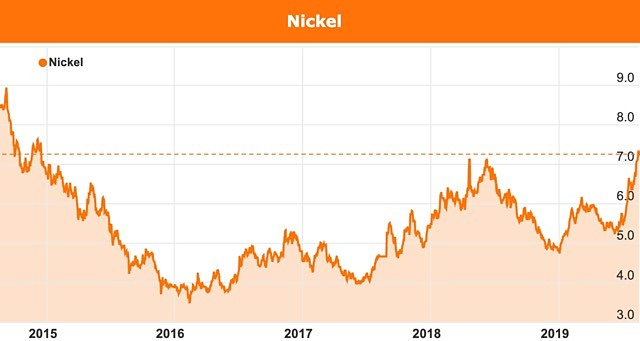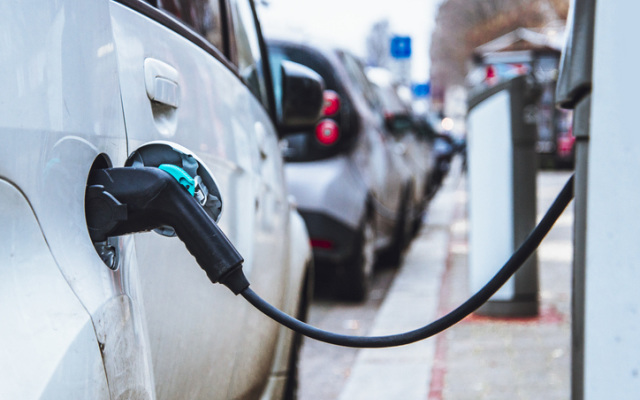BHP Group and Western Areas forecast big future for nickel as price continues climbing

Miners such as BHP and Western Areas are poised to take advantage of the mounting demand for nickel.
Despite global economic headwinds and the ongoing trade war, nickel’s price has continued climbing in recent weeks with nickel producers BHP Group (ASX: BHP) and Western Areas (ASX: WSA) both forecasting a positive future for the commodity in their latest updates.
Nickel pushed past US$7 per pound (US$16,000/t) this month reaching US$7.30/lb (US$16,090/t) last Friday as stockpiles on the London Metal Exchange continue eroding.

The nickel price has surpassed its 12 month high.
Nickel’s stockpile at the LME has remained under 150,000t since late July – slipping to 141,906t earlier this month, before rebounding slightly to reach 149,640t on Tuesday.
Jervois Mining (ASX: JRV) executive general manager Michael Rodriguez told Small Caps the stockpile figure represented less than two months’ worth of nickel supplies.
Analysts and miners have been predicting nickel’s resurgence for the last two years, but the comeback has been stunted by the ongoing trade war between US President Donald Trump and China’s President Xi Jinping, which heated up mid-last year and remains volatile.
However, global uncertainty hasn’t been able to keep the nickel market subdued endlessly, with underlying fundamentals remaining strong – driven by continuing growth in the metal’s primary end-market stainless steel.
In addition to stainless steel, a new market for nickel is emerging in the lithium-ion battery space, which is surging on the back of global electric vehicle demand.
Nickel is a critical element in the nickel, manganese, cobalt (NMC) cathode formula for lithium-ion batteries used in electric vehicles.
Each electric vehicle with an NMC lithium-ion battery requires about 50kg of nickel.
Stainless steel and batteries vie for nickel
Mining behemoth BHP’s vice president of market analysis and economics Dr Huw McKay said although stainless steel would continue to be the metal’s primary end-use for many years, he envisages a future where batteries and stainless steel become “equally important” nickel consumers.
He said nickel’s future in this sector will be dependent on several factors including how fast EVs can penetrate the auto fleet, the mix of battery chemistries that will eventually power these vehicles and the cost of converting nickel laterite into a battery grade nickel product.
Looking ahead, Mr McKay noted BHP’s lowest plausible scenario was that by 2035 EVs will make up 7% of light vehicles on the road, with this anticipated to expand to 27% by 2050.
Putting a number on these percentages – the company expects to see 132 million EVs on the world’s roads by 2035 and 561 million in 2050.

BHP forecasts 1.6 billion EVs could be on the world’s roads by 2050.
In a more bullish forecast, Mr McKay said the world’s EV fleet could surpass 700 million by 2035 – rising to 1.6 billion by 2050.
Driving the rise of EVs is an ongoing decline in average battery costs with Bloomberg New Energy Finance estimating a full battery pack now costs less than $180 per KWh – down from $290/kWh only two years ago.
When looking at the main battery chemistry that will power these vehicles, Mr McKay pointed out “no battery is perfect” and there would be “trade-offs” with any battery chemistry that is selected.
However, he noted nickel rich chemistries “present the best opportunity to achieve the positive performance” that is required at an “acceptable cost” and manageable weakness.
“We expect the NMC 8-1-1 to be the workhorse technology of the EV future.”
With nickel demand currently about 2Mtpa, this is expected to grow to around 6Mtpa by 2035. Batteries are forecast to account for almost half that need.
To take advantage of this expected growth, BHP is looking to boost its nickel sulphide resources.
Compared to nickel laterite deposits, nickel sulphide resources are less costly to process into battery grade nickel.
Western Areas receives increasing interest from lithium-ion battery market
In today’s full year results presentation, Western Areas managing director and chief executive officer Dan Lougher revealed the company had received a “significant increase” in offtake enquiries for its nickel sulphide concentrate.
He said the company’s existing offtake contracts with BHP Nickel West and China’s largest steel producer Tsingshan are due to expire early next year.
Although stainless steel is expected to remain nickel’s primary market for many years, Mr Lougher noted the higher interest in the company’s products was arising primarily from the lithium-ion battery sector.
Dry pipeline and vying markets
As nickel’s primary market in stainless steel continues to strengthen and NMC lithium-ion batteries are installed in even more electric vehicles, manufacturers and investors are increasingly looking at available nickel supply.
This poses a problem with little investment made in discovering and advancing nickel projects over the past decade – resulting in the nickel market slipping into a deficit in 2016.
As demand intensifies this deficit is anticipated to continue through to at least 2025.
Even with the nickel price rising in recent weeks, Mr Lougher said it was still too low to incentivise new projects and mines.
